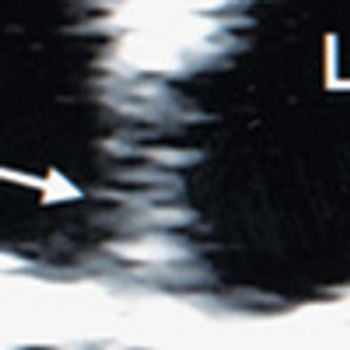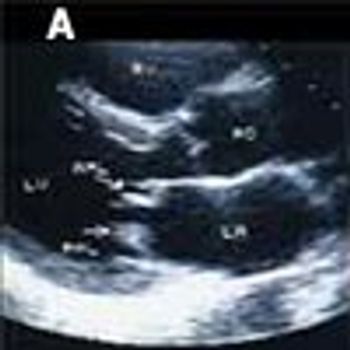
Forty-eight hours ago, a 39-year-old man presented to the emergency department with emesis and severe upper abdominal pain of semi-acute onset, which radiated slightly to the back.

Forty-eight hours ago, a 39-year-old man presented to the emergency department with emesis and severe upper abdominal pain of semi-acute onset, which radiated slightly to the back.

A 63-year-old man with a history of hypertension and gastroesophageal reflux disease presented with progressive, sharp mid-abdominal pain of 3 weeks' duration.

Interatrial septal aneurysm (IASA) and patent foramen ovale (PFO)-either alone or coexisting-are a frequent cause of cryptogenic cerebral and/or peripheral thromboemboli. The IASA plus PFO combination has been shown to confer higher risk, particularly in adults aged 45 years or younger. Therefore, recognition and documentation of these 2 abnormalities during an echocardiographic (transthoracic or transesophageal) study, when performed for other indications, is essential.

I read with interest Dr Gregory Rutecki's response to a reader's comments (CONSULTANT, February 2007), in which he emphasized the need for early screening and treatment of cardiovascular disease in patients with chronic kidney disease (CKD).

A 68-year-old woman with hypertension complains of intermittent dyspnea and light-headedness. She is asymptomatic during the evaluation. Vital signs are normal, but an irregularly irregular pulse is noted on examination as well as on the telemetry monitor. The 12-lead ECG is shown here; the ECG machine printout reads "atrial fibrillation." The patient has no history of this arrhythmia.

Current evidence suggests that out-of-office blood pressure measurements and 24-hour ambulatory blood pressure monitoring are better predictors of cardiovascular risk than routine office measurements. Is it time to make greater use of automated devices in my practice?

My patient is an 82-year-old woman with a history of coronary artery bypass grafting (CABG), chronic obstructive pulmonary disease (COPD), pulmonary hypertension, and mild intermittent angina on exertion, which is relieved by sublingual nitroglycerin.

ABSTRACT: Angiotensin-converting enzyme inhibitors and ß-blockers are the cornerstone of heart failure medical therapy; unless contraindicated, start these agents as soon as possible after volume status has been optimized. Aldosterone receptor antagonists, angiotensin-receptor blockers, and a fixed-dose combination of hydralazine and isosorbide dinitrate (the last recommended especially for African Americans) can be used as add-on therapy. Prophylactic implantable cardioverter defibrillators reduce long-term mortality in symptomatic patients with a left ventricular ejection fraction (LVEF) of 35% or less. Cardiac resynchronization therapy improves symptoms and ventricular remodeling in some patients; indications include wide (more than 20 milliseconds) QRS complex on ECG, impaired LVEF (35% or less), and advanced heart failure symptoms (NYHA classes III and IV) despite optimal drug therapy. Measurement of natriuretic peptides and impedance cardiography both show promise for monitoring patients with heart failure and for guiding therapy, but definitive data to justify their routine use are still lacking.

Having suffered many assaults on my eardrums from patient vocalizations during auscultation for carotid bruits, I now ask patients to take a deep breath and hold it as I listen to the vessels in their neck.

At a routine blood pressure check, a 63-year-old woman has 2 readings of 165/100 mm Hg. The patient has had essential hypertension since age 41 years. For more than a decade, it was easily controlled with a b-blocker; however, in recent years, her blood pressure has been more variable, with occasional readings of higher than 150/90 mm Hg.

Heart failure is prevalent in both primary care and cardiology practices. It develops in about 1 in 5 persons during their lifetime and in about 1 in 8 of those who have not sustained a myocardial infarction (MI). Heart failure is also the leading cause of hospitalization in the elderly.

Lp(a) is a fascinating variant of low-density lipoprotein (LDL). It is basically an LDL molecule that has been modified by the covalent addition of apoprotein(a). Elevated levels of Lp(a) correlate with increased risk of acute coronary syndromes, cerebrovascular accident, peripheral arterial disease, and coronary mortality. This Q&A session answers some curiosities about Lipoprotein(a).

A 67-year-old woman arrived via ambulance in ventricular tachycardia. She had been experiencing crushing substernal chest pain and shortness of breath that had worsened over the past several hours. She received oxygen (by mask) and lidocaine (100 mg intravenously) en route to the emergency department (ED), but there was no change in the rhythm.

ABSTRACT: Atypical clinical presentations in the quality, intensity, and radiation of pain are common in patients with acute coronary syndromes. Women with an acute myocardial infarction (AMI) are more likely to have atypical symptoms, such as dyspnea, than men. A history of acute anxiety or a psychiatric diagnosis does not preclude the possibility of an acute coronary event in a patient with chest pain. The clinical response to a GI cocktail, sublingual nitroglycerin, or chest wall palpation does not reliably identify the source of pain. Over-reliance on tests with poor sensitivity, such as the ECG, or on the initial set of cardiac biomarkers will miss many patients with MI. Serial troponin levels obtained at 3- to 6-hour intervals are recommended to evaluate the extent of myocardial damage. Coronary angiography that detects mild non-obstructive disease does not exclude the possibility of sudden plaque rupture and acute coronary occlusion.

In patients presenting with severe hypertension, what constitutes a true emergency?

Is it necessary to prescribe lipid-lowering therapy for a patient with a mildly elevated total cholesterol level (240 mg/dL), a low-density lipoprotein (LDL) cholesterol level of 120 mg/dL, and a high high-density lipoprotein (HDL) cholesterol level of 100 mg/dL?

Torsades de pointes, or polymorphic ventricular tachycardia, seen on ECG includes wide complex QRS morphology tachycardia, axis deviation of the QRS complexes around baseline.

A 49-year-old woman was referred for evaluation of cardiac valvular dysfunction. Years earlier, she had taken phentermine and fenfluramine for 3 to 6 months for weight loss. She had lost 6.75 kg (15 lb) during that interval without any cardiac symptoms or side effects. She stopped taking the drug on her own.

A 50-year-old man with end-stage renal disease secondary to long-standing hypertension had an elevated hematocrit and progressively increasing hemoglobin levels. For the past 7 years, he had been receiving hemodialysis 3 times a week. He denied headache, flushing, easy bruising, bleeding, nausea, vomiting, chest pain, dyspnea, and other symptoms. He was not receiving exogenous erythropoietin.

ABSTRACT: In addition to appropriate pharmacotherapy and assistance with smoking cessation, a secondary prevention plan should include counseling about a heart-healthy diet, a structured exercise program and/or increased physical activity, and assessment of psychosocial risk factors, such as depression. Advise patients to reduce their intake of salt, sugars, refined carbohydrates, and saturated and trans fats; incorporate more fruits, vegetables, and fish into their diet; and balance caloric intake and physical activity to achieve and maintain a body mass index between 18.5 and 24.9 kg/m2. Cardiorespiratory fitness is the key to cardioprotection; the threshold for improving it in persons with coronary heart disease is about 70% of the mea-sured maximal heart rate. Encourage patients to engage in multiple short bouts of physical activity daily, such as taking the stairs instead of the elevator or walking the dog. Among previously sedentary persons, this approach has effects on cardiorespiratory fitness, body composition, and coronary risk factors similar to those of a structured exercise program.

A 57-year-old man requests an extensive medical evaluation as part of a transition in the ownership of his business. He is generally healthy, although he reports that his capacity for physical exertion has diminished over the past several years. He denies chest pain with effort, dyspnea at night or on exertion, cough, and sputum production.

ABSTRACT: Patients who experience an acute myocardial infarction (MI) are at very high risk for recurrent cardiovascular events. Both site-supervised and home-based cardiac rehabilitation programs can effectively reduce all-cause and cardiovascular mortality. Start risk factor reduction as soon as possible; pharmacotherapy is best initiated while patients are still in the hospital. All patients who have had an MI should receive aspirin, an angiotensin-converting enzyme inhibitor, and a ß-blocker, unless these agents are contraindicated or are not tolerated. Prescribe aggressive lipid-lowering therapy to bring patients' low-density lipoprotein cholesterol levels to below 70 mg/dL. For smokers, quitting is the single most important change they can make to reduce future risk of MI.

What is "normal" blood pressure (BP)? Is it different from optimal BP?

For several months, a 52-year-old woman has had burning discomfort in the region of her lower sternum and frequent acid/sour sensations in her throat; the symptoms are usually associated with burping after meals and recumbency.

A 24-year-old woman presents to the emergency department (ED) withgeneralized weakness, headache, and muscle cramping that have progressivelyworsened over the past week. Recently, she has also had nauseaand vomiting. She denies chest pain, palpitations, dyspnea, cough, fever,chills, diarrhea, and urinary symptoms. She has a history of type 1 renaltubular acidosis.